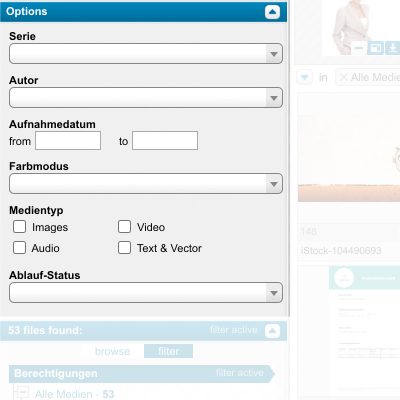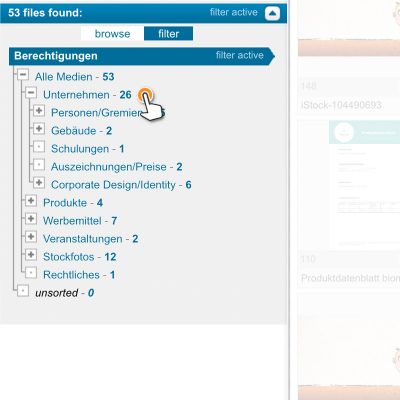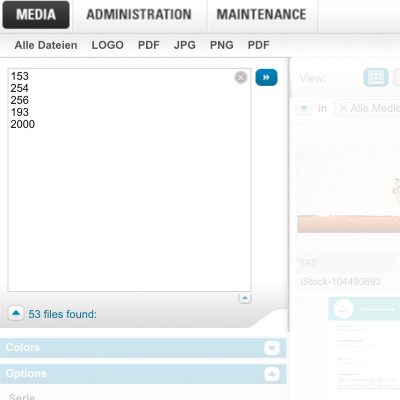Find & organize files
Find files with the multifunctional search
Manja Digital offers you various search tools suitable to your respective requirements: Full text search, color search, advanced search options, search in categories and predefined search terms.
To find the right files, the search is a very essential tool. Because: you don’t only want to search, but also to find the right thing. In this chapter we describe which possibilities the Manja search offers.
Tip: On our page Features & Add-ons we have compiled an informative overview of all our features. Additionally, we offer a general description about multifunctional search and how files are organized and managed in Manja.
Full Text Search
Back to top
The full text search finds the exact result for your search term. You can look for individual terms but also make complex, compound queries.
Refine the search with placeholders
The search function accepts the placeholder * (star) for any amount of letters and the placeholder ? (question mark) for an individual letter.
Examples for placeholders:
- House* – words such as House, Household, Houseboat, etc. are accepted
- ?ouse – words such as House, Mouse, Louse, etc. are accepted
- *ouse – the same words as for ?ouse, but also words like Grouse, Blouse, Warehouse, etc. are accepted
Combine with operators
Search terms can be combined by means of the three operators AND, OR and NOT. There are several synonyms for these operators:
Useful operators:
- AND, &
- OR, |
- NOT, !
More combination options
The combination of search terms is largely based on regular linguistic phrasing. You can use commas as separators for a list of terms and insert an operator in front of the last term only.
For example, the phrasing “House, Building or Construction” is equivalent to the search “House OR Building OR Construction”. If an operator is missing, the AND operator is used. Thus, the phrasing “Berlin, Wall, Graffiti” corresponds to the search “Berlin AND Wall AND Graffiti”.
You can use parentheses for partial expressions. Parentheses may also be nested. Any kind of complex search query is thus possible, if required.
Examples for combinations:
- House and tree
- House or building or construction
- House, building or construction
- House, tree and sun
- House, tree and sun or sunset
- (House, tree and sun) or sunset
- house, tree and (sun or sunset)
- Berlin and not wall
- Berlin & !wall
- Berlin and not (wall, parliament or November)
- Berlin and wall
- Berlin, wall
- Berlin & wall
Automatic operator selection
If the operator itself is to be searched, you can enclose it in double "" quotes.
Examples for automatic operators:
- For Better “Or” For Worse
Color Search
Back to top
Using color search you can look for images with one or more dominant colors.
Here you can select up to three colors and Manja will supply you the images matching the given colors, sorted by relevance.
The search variant by color can also be combined with the full text search as well as with the search in categories.
Advanced Search Options
Back to top
In the advanced search options category, options specifically matched to the contents of the database can be stored.
For example
selection by
● author,
● series
● special keywords
● date taken
● color mode
● file type
● etc.
The options available are configured within the Administration.
Search in Categories
Back to top
Files can be cataloged via categories by subjects or other criteria. You can define one or several category trees (for example “departments” and “topics”).
The individual files can (but don’t have to) be arranged into the respective trees.
Search process in categories
In order to find all files of a category, you simply click on the appropriate category, without starting a search beforehand.
In order to limit the search results to one category, you click on that category and then use the fulltext search. Or vice versa: first start a fulltext search, and then select the category on that you want to restrict the search results.
Next to the category, the total number of files in the respective category is shown in blue and bold. After a search, the number of hits applying to your query is shown in grey and normal text.
Display in categories according to permissions
In any case, only those files are shown that you are authorized to access. If you have just guest or limited access, then please request expanded access privileges from your contact person.
Browse and Filter Modes
Principally, there are two modes of navigation within categories:
Browse Mode
Categories are selected individually, the navigation within categories works similarly to a navigation in folders of a file system. The result list will show files of the selected category only.
Filter Mode
Multiple categories can be selected, sub categories will be selected automatically. The result list will show files of the selected category as well as files from all sub categories.
Keywords / Tags
Back to top
Frequently used, recurring or important search words can be placed below the navigation bar as so-called tags for quick access. Clicking on the tag creates a search, which shows up-to-date, appropriate results.
In order to create or edit tags Administrator privileges are required.
You can find more information about this in Manja: Administration -> Settings, Texts, Formats -> Settings
Special Search Requests
Back to topAdditionally to the above-mentioned, apparent search tools, there are further ones:
Search in Metadata fields
To search in specific individual metadata fields, use the fulltext search: enter a dollar sign ($), followed by the ID of the metadata field. Then enter a space, followed by your search term.
Examples:
- Search for “Berlin” in the Title: “$101 Berlin”
- Search House, Mouse, Louse etc. in the Title: “$101 ?ouse”
- Search for files without a Description: “$104 “
You can look up metadata field IDs in the Administration, in section Metadata.
This search method is also used when clicking on metadata text in the detail view of a file.
Search for similar files
To find files with a similar color scheme as a given file, you can use the fulltext search: enter a tilde sign (~), followed by a file ID (of the comparator file).
You may also enter multiple file IDs, separated by comma. In this case, the files that match the color scheme of all given files at best will be found.
Examples:
- Search for files with color scheme similar to that of file ID 94354: “~94354”
- Search for files with color scheme best matching those of three different files: “~94354,94356,98367”
List search
Back to top
Click on the small arrow icon below the search input field to open list search.

Now enter each search term on a separate line and all terms will be searched for at the same time.